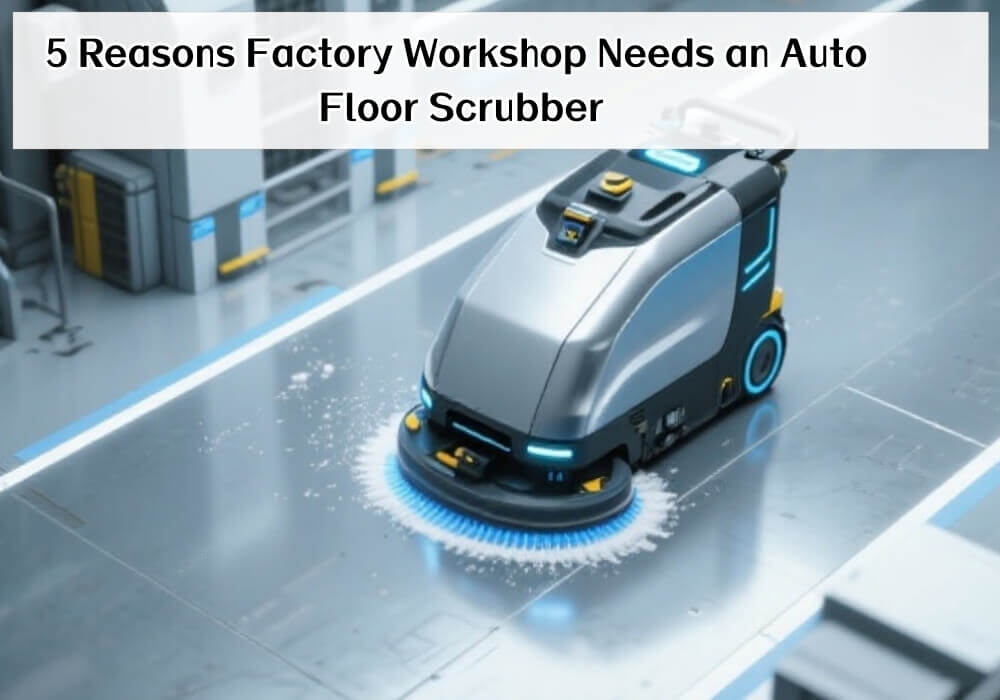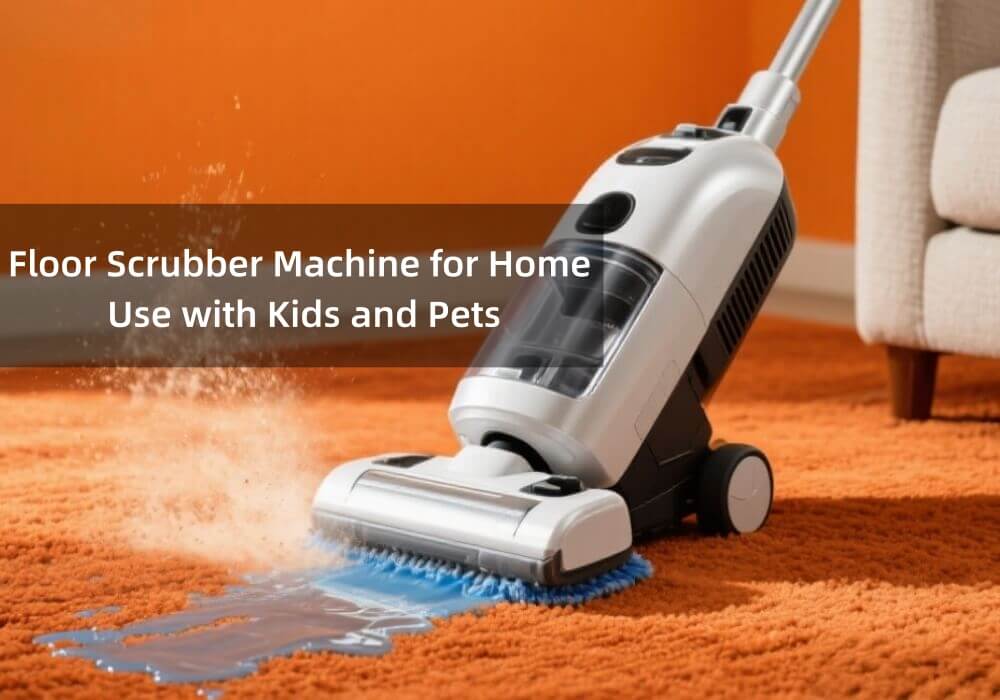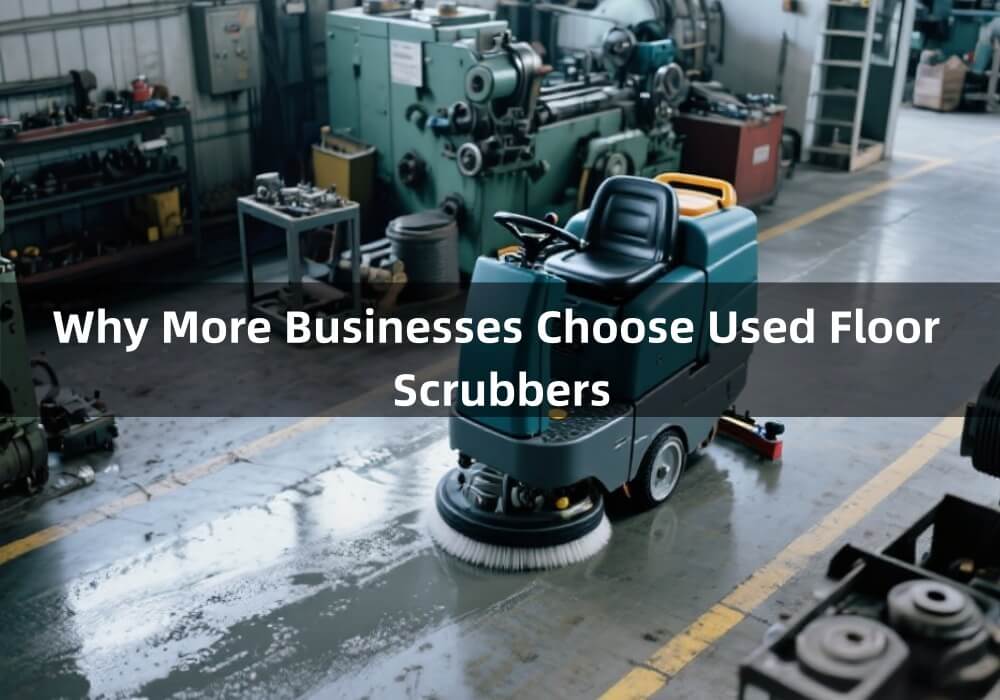Introduction
In the field of industrial cleaning and floor maintenance, industrial floor scrubber machine and industrial polishing machine are two highly specialized and widely used equipment. Although both serve ground processing, there are essential differences in core positioning, working principles, performance parameters, and other dimensions.
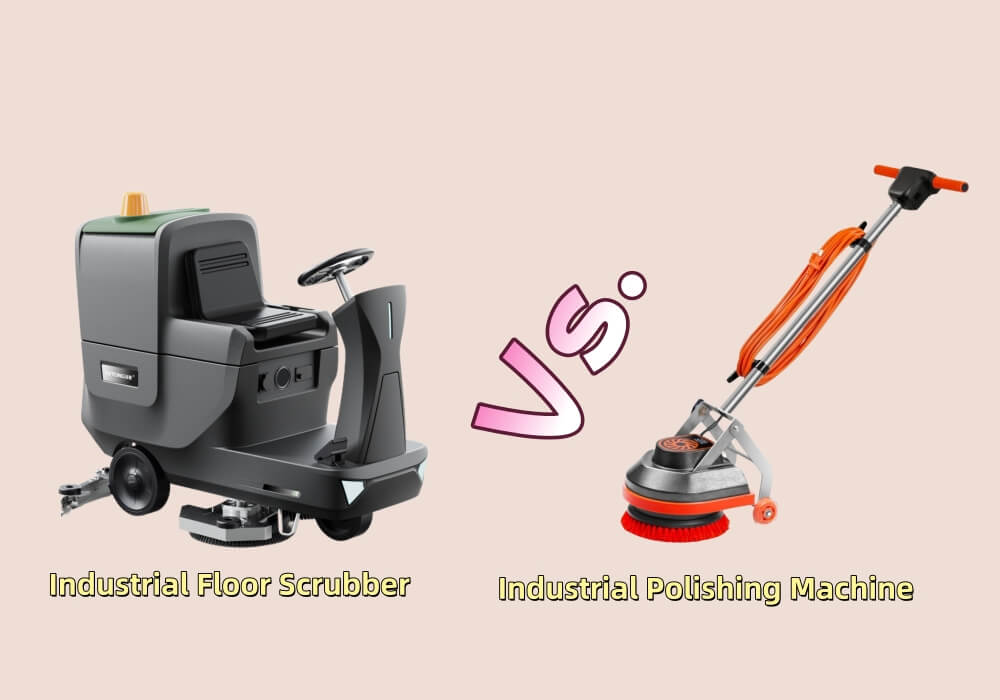
Positioning
What is an Industrial Floor Scrubber?
The core positioning of a floor scrubber is to efficiently remove floor stains, dust, and debris, as well as solve the problem of floor pollution in industrial settings. Its purpose is to maintain the cleanliness of the ground foundation and prevent safety hazards caused by oil pollution and dust accumulation. Floor scrubbers are mainly divided into two types:
- Walk behind Floor Scrubber:It is suitable for small and medium-sized areas, manually pushed by the operator. Commonly used in schools, offices, and retail stores.
- Ride on Floor Scrubber:It is suitable for larger spaces such as warehouses and industrial facilities, allowing operators to cover larger areas in a shorter amount of time.
We previously wrote an article about Why it is necessary to use an industrial floor scrubber. It has significant advantages in both performance and cost. In addition, what are the characteristics and advantages of a floor scrubber compared to an industrial polishing machine?
What is an Industrial Polishing Machine?
The core positioning of the polishing machine is to optimize the texture and glossiness of the ground surface, and solve the problem of "insufficient aesthetics" of the ground. Its purpose is to enhance the visual effect of the ground and extend the service life of the ground. Floor polishing machines are mainly used in public and commercial areas with high requirements for ground appearance, such as shopping mall halls and hotel halls.

Working Principle
Based on different positioning, two types of devices are different in working technology paths.
Industrial Floor Scrubber: Wash - Scrub - Blot dry
The specific working principle can be divided into the following steps:
Water Supply System: A water tank sprays clean water onto the brush disc, moistening floor stains and reducing their adhesion.
Mechanical Scrubbing: A motor drives the brush disc, which rotates at high speed. The friction between the bristles and the floor removes oil, dust, and other stains.
Wastewater Recovery: A squeegee behind the brush plate maintains close contact with the floor, creating negative pressure through a vacuum pump to draw cleaned wastewater and debris into a wastewater tank.
Instant Drying: The floor dries quickly after cleaning, preventing secondary contamination and the risk of slips.
Industrial Polishing Machine: Grinding - Polishing - Maintenance
The specific working principle can be divided into the following steps:
Rough Grinding and Leveling: Use a low-grit grinding disc to remove scratches, dents, or aged surfaces through high-speed rotation, resulting in a smooth surface.
Fine Grinding and Polishing: Use a high-grit grinding disc to further refine the surface texture. A polishing agent is also used to create a protective film on the surface, enhancing its gloss.
Gloss Curing: Some polishing machines are equipped with hot air or ultraviolet curing functions. It can accelerate the formation of the protective film and make the gloss effect more durable.
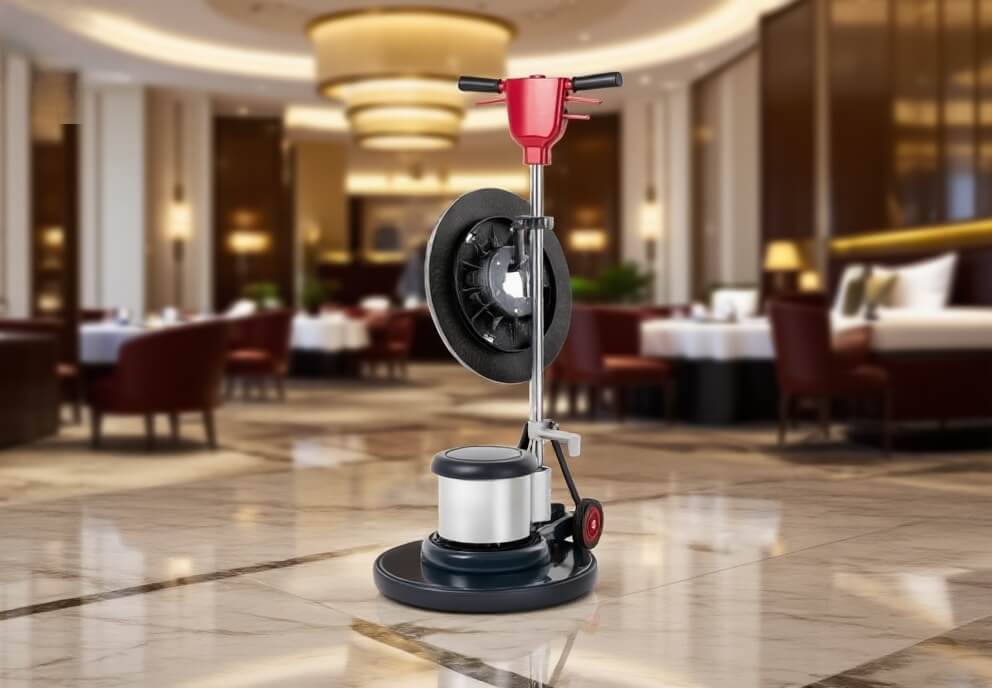
Core Structure
In order to achieve different work goals, there are significant differences in the design of core components between floor scrubbers and polishers.
Industrial floor scrubber | Industrial Polishing Machine | |
Fitting | Brush disc/ Roller brush (1-2, diameter 300-600mm), Squeegee | Grinding discs / Polishing pads (1-4, 150-500mm diameter) |
Water Tank | Dual water tank design (Fresh water tank 50-300L, sewage tank 60-350L), with water level monitoring | Single water tank (capacity 10-50L), only used for spraying polish |
Power System | Low-voltage motor (48V/72V), focusing on torque (driving brushes and water pumps) | High-voltage motor (220V/380V), focusing on speed (driving the grinding disc to rotate at high speed) |
Adjuster | Brush plate pressure regulator (50-150N) , Adapt to different stain intensity | Grinding disc pressure regulator (20-80N) , Avoid excessive grinding and damage to the ground |
Travel System | Large diameter rubber wheels (150-250mm in diameter), with brake function, suitable for complex terrain | Small diameter polyurethane wheels (80-150mm diameter) , focus on stability and avoid drift |
Control System | With sewage overflow alarm and squeegee lift-off detection, it focuses on "clean closed-loop monitoring" | With speed adjustment and polishing agent remaining reminder, focusing on "polishing precision control" |
Conclusion: From a structural point of view, industrial floor scrubbers focus more on cleaning efficiency and wastewater recovery. it needs to be equipped with large-capacity water tanks and strong suction systems. On the other hand, industrial floor polishing machine focuses on polishing accuracy and ground protection. It pays more attention to motor speed control and grinding wheel pressure adjustment.
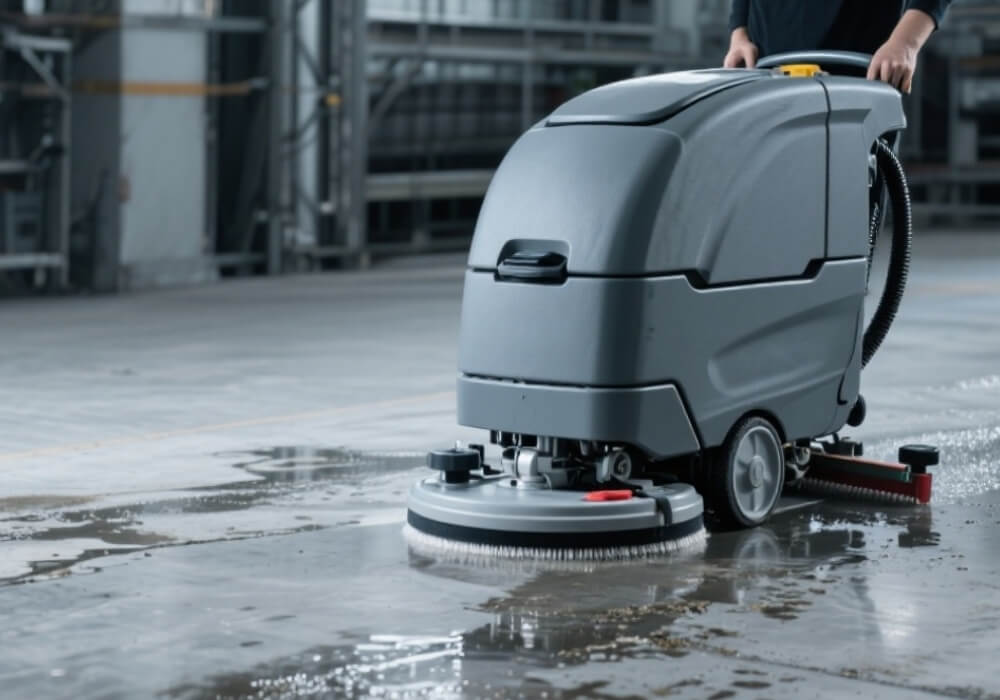
Performance Parameters
The performance indicators for the two types of cleaning equipment are completely different. So companies need to focus on core parameters when selecting equipment.
Industrial Floor Scrubber: Focusing on Cleaning Efficiency and Performance
Floor scrubber performance depends on four core parameters:
- Cleaning Width: The width of the brush disc (typically 500-1200mm) determines the area cleaned per unit time.
- Water Absorption Efficiency:It refers to the rate at which the squeegee recovers wastewater (typically 10-30L/min), it directly impacts the drying speed of the floor.
- Battery Life:The continuous working time of the battery-powered floor scrubber (usually 2-8 hours) must match the company's cleaning shifts.
- Sewage Tank Capacity:It determines the actual working time of the equipment (generally 50-350L). Severely polluted workshops (such as food processing) require a sewage tank ≥
Industrial Polishing Machine: Polishing Effect as the Core Performance
Polishing machine performance mainly depends on the following four parameters:
- Disc Speed:It refers to the number of times the disc rotates per minute (usually 1000-3000 rpm). The higher the speed, the better the polished gloss.
- Disc Mesh: This refers to the coarseness of the abrasive particles on the disc surface (usually 50-2000 mesh). The higher the mesh, the smoother the surface.
- Gloss Improvement:This refers to the difference in floor gloss before and after polishing. A high-quality polisher can achieve a 50-60°
- Polishing Efficiency:This refers to the area polished per unit time. For large areas like shopping malls, equipment with a capacity of 300 square meters/hour or higher is recommended to ensure efficient nighttime maintenance.
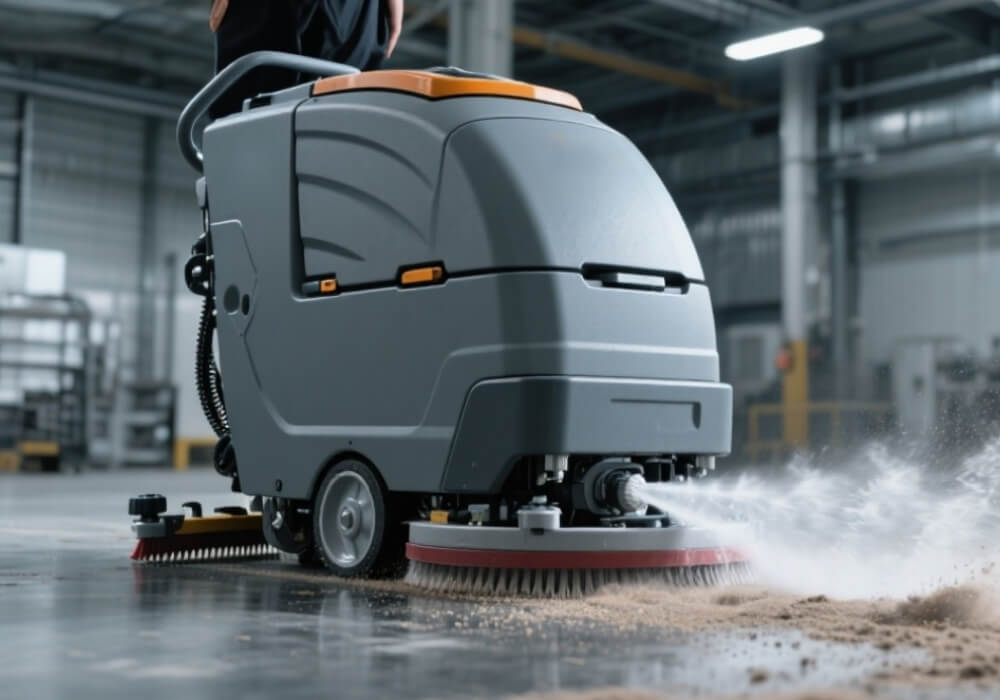
Application Scenario
The two types of industrial cleaning equipment also have differences in the subdivision of application scenarios.
Industrial Floor Scrubbers: for Frequent and Deep Cleaning
- Industrial Environments:Warehouses, manufacturing plants, logistics centers
- Commercial Facilities:supermarkets, airports, hospitals
- Public Spaces:subway stations, parking lots
Industrial Polishing Machine: For Beauty and Maintenance of Floor Quality
- Retail and Hospitality:Shopping malls, hotel lobbies, exhibition halls
- High-end Office:Corporate lobbies, conference rooms
- Specialty Flooring: Stone maintenance, epoxy floor maintenance
Scenario Type | Applicable Device |
Factory Workshops (automobiles, machinery) | Industrial Floor Scrubber |
Logistics Warehouses (e-commerce, express delivery) | Industrial Floor Scrubber |
Basement Garages (commercial, residential) | Industrial Floor Scrubber |
Food Processing Workshop | Industrial Floor Scrubber |
Mall Lobby (shopping mall) | Industrial Floor Polisher |
Hotel Lobby (high-end hotel) | Industrial Floor Polisher |
Office Building Corridor (office area) | Industrial Floor Polisher |
Airport Terminal | Industrial Floor Scrubber + Industrial Floor Polisher |
Cost Investment
Ride on Floor Scrubber | Multi-disc Polishing Machine | |
Initial Purchase Cost | 4200-11000$ | 7000-21000$ |
Single Maintenance Cost | 10-30$ | 30-70$ |
Annual Maintenance Cost | 140-420$ | 700-1400$ |
Consumable Parts Replacement Cost (Annual) | Brush plate + Water-absorbing tape: 140$ | Grinding disc + Carbon brush: 430$ |
Energy Cost (Annual, 8 hours per day) | Electricity cost: 115$ (48V battery, charging power 2kW) | Electricity cost: 340$ (380V motor, power 7.5kW) |
Total cost over 5 years | 7000-17000$ | 21000-42000$ |
When choosing to purchase cleaning equipment, companies need to consider the initial and long-term use costs of the two types of equipment.
Conclusion: From a long-term cost perspective, industrial floor scrubbers have lower overall costs and are suitable for companies that focus on cleaning efficiency. On the other hand, Industrial polishing machines are more expensive, but they can bring long-term value in situations where high appearance is required.

Operation and Maintenance
The operation difficulty and maintenace cost directly affect the company's manpower input and long-term use costs.
Industrial Floor Scrubber
- Operational Difficulty:Most floor scrubbers feature a one-button start design, New users can operate them independently after 1-2 hours of training.
- Maintenance:Maintains the scrubber primarily in three areas: the brush plate, squeegee, battery, and water tank.
Industrial Polishing Machine
- Difficulty of Operation:The polishing machine's speed, pressure, and grit size must be adjusted according to the surface material. Improper operation can easily lead to scratches or uneven gloss. Furthermore, operators require 2-3 days of professional training.
- Maintenance:This primarily involves four areas: the polishing disc, carbon brushes, pressure sensor, and polishing compound delivery tube.
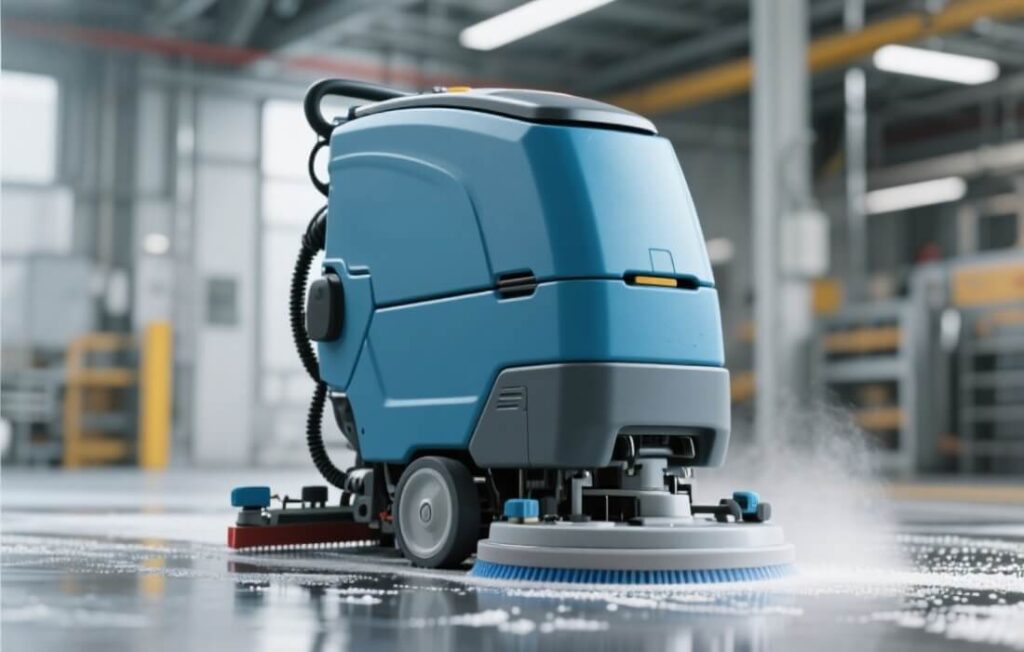
Procurement Recommendations
Enterprises can choose floor scrubbers or polishing machines based on the following purposes.
Purpose 1: Cleanliness or Beauty
- If the requirement is to clean stains and improve cleaning efficiency, you can choose an industrial floor scrubber
- If the need is to increase gloss and optimize appearance, itcan choose industrial polishing machines
- If the requirement is daily cleaning and regular maintenance, you can choose a combination of industrial floor scrubber + industrial polisher.
Purpose 2: Matching Scene Parameters
- Selecting a floor scrubber:Consider factors such as the cleaning area, stain type, and floor material.
- Selecting a polisher:Consider factors such as floor material, target gloss level, and maintenance frequency.
Purpose 3: Cost Assessment
- Limited Budget (<700$):Choose a walk behind floor scrubber to meet the cleaning needs of small and medium areas
- Medium Budget (7000-14000$):Workshops can choose a ride-on floor scrubber, and shopping malls can choose a small polisher.
- Sufficient Budget: (>14000$):For large-scale scenes, choose a large floor scrubber; for high-end shopping malls, choose a multi-disc polisher

Conclusion
Although industrial floor scrubbers and polishers are both floor maintenance equipment, they differ in their functions and uses. Industrial floor scrubbers focus on cleaning and sanitation, while polishers focus on beauty and protection. In general, both of them contribute to optimizing and maintaining a company's image. With technological advancements, industrial floor scrubbers and polishers are becoming more intelligent and sustainable. They will play an even more important role in the future.

